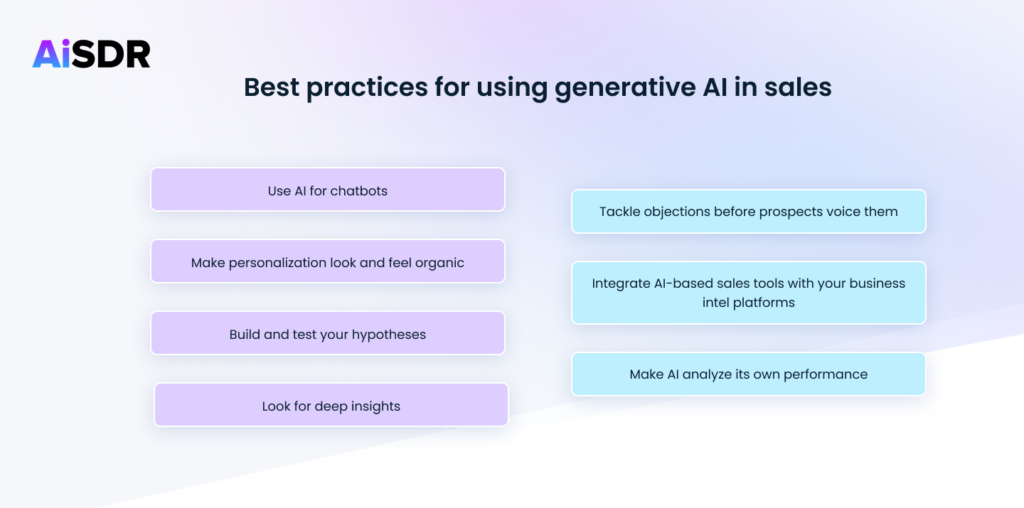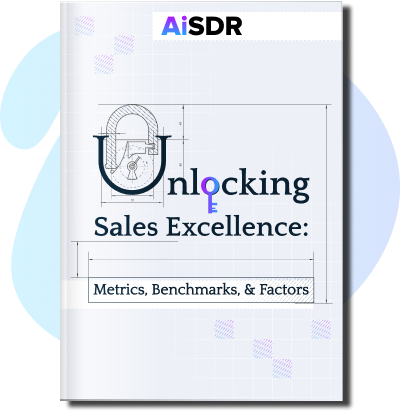More Demos, Less Hussle: How Generative AI Helps Sales Teams

Gen AI is a hot topic in sales. Find out the best ways to use it, and get it to nail the task it is given
Even with a superb product, companies will go nowhere without an efficient and effective sales department. In a highly competitive market, customers can always turn to more persuasive competitors.
In this context, automation and AI-based tools are a must for your sales team. For example, when Virgin Pulse implemented conversational AI lead scoring, they saw an impressive fourfold increase in top-of-funnel conversions. AI enhanced their communication with prospects by analyzing their sales reps’ customer calls, enabling more targeted training and peer collaboration.
The use of tech is no longer an option, it’s a necessity. For sales teams, sticking to manual processes means losing revenue as time kills deals.
How to use innovative tech to nurture your leads on a timely basis, book more sales demos, and get more deals closed? Generative AI is the perfect tool for this.
What is generative AI?
Generative AI is a type of artificial intelligence that focuses on creating new ideas, scripts, recommendations, images, or other content, based on the information it learned from existing data and the rules laid down in its algorithm. The first example that comes to mind is ChatGPT, and although salespeople can use it, it’s not specialized for sales.
But these alternatives – Viva Sales by Microsoft and Einstein GPT by Salesforce – are. The apps have many features that can benefit sales departments, like creating contextual email replies or taking meeting summaries
And not only that. Here’s a closer look at how AI works to improve your sales team’s performance.
How can AI help in your work?
Generative AI for sales is far more than a fleeting fad. It has the real potential to fundamentally change the way sales teams work.
These are some of the main benefits of AI in the workplace.
Automating mundane tasks
AI can tackle repetitive tasks in sales, like lead scoring and segmenting. By analyzing prospect data like demographics and online behavior, these systems draw insights that help guide SDR outreach.
So, rather than having to sort through data manually, the AI for sales automates the job. This way, you can shift your focus to more rewarding activities, like connecting with promising leads.
Detecting best practices based on communication
AI can process recordings and transcripts of sales dialogues across calls, emails, and chats to identify effective patterns and top practices.
With AI support, your agents won’t have to log everything they learn manually. Instead, they’ll have a smart assistant that compiles and organizes guides for them. Anytime, sales teams can refer to these resources to fine-tune persuasive messaging, overcome common obstacles, and ultimately build meaningful customer connections.
Personalizing prospects’ interactions
By reviewing data on previous customer engagements, AI sales systems can provide customized recommendations on communication styles and expected promotions. With these insights, reps can lead more relevant conversations.
Forecasting sales dynamics
The AI tool can make sales forecasting way smarter, too. AI for sales can analyze historical data — past sales contracts, market trends, budget plans, etc. — and generate reliable predictions. You can set informed targets knowing the projections are grounded in reality.
Analyzing its own performance
Finally, as AI evolves, it can self-improve through learning. The system can assess its own forecasting accuracy against real results. This way, the AI can refine its models and enhance precision over time.
With less time across the sales funnels and more targeted communication, sales departments will book more demos and close more deals. For this to come true, though, sales representatives should know how to analyze the data their AI assistants generate.
How to analyze AI data
Analyzing AI output may look and seem overwhelming, but anyone can do it. This is what you have to do:
- Centralize your data – Connect your CRM, email platform, sales software, and AI sales systems so you can get the full picture.
- Pick key metrics – Track sales metrics like lead response time, time to close deals, scheduled demos, call sentiment analysis, customer value, and more. Display them on dashboards.
- Dig into the data – Filter the dashboards by date, region, product, rep, etc. Spot sales reps, deals, and campaigns doing well or poorly.
- Investigate the reasons – Define the reasons behind performance, good or bad. It might be how reps interact with customers, follow up, show empathy, etc.
- Discuss improvements – With the biggest drivers spotted, discuss what can be improved and develop corresponding strategies for training, establishing new procedures, etc.
- Repeat – Keep analyzing AI data regularly to see the impact of changes and find new sales opportunities.
You can gain huge value from AI data by going through this process: connect, define, dig, investigate, communicate, and repeat. Just as Virgin Pulse discovered, AI tools can drive everything from team collaboration to conversion rates.
Tools for improving sales
Sales teams are blessed with a plethora of awesome AI platforms. Here are some high-impact options for AI sales systems:
- AiSDR is an AI-powered tool for sales teams and marketers that automates lead qualification, schedules meetings with leads, and creates effective sales campaigns in minutes on full autopilot.
- Sapling helps representatives create faster, more personalized responses across all touch points. It suggests responses and autocomplete messages to help teams respond faster to more clients.
- Second Nature provides interactive sales training simulations so reps can improve their skills through practical experience.
- Writecream generates sales and marketing content like emails, social media posts, and articles. It can also create visual content from concepts, saving on designers.
- Copy.ai is another type of AI in sales and marketing. For sales teams, the tool handles lead generation, opportunity management, and sales enablement.
- Chorus transcribes past sales interactions, like calls and emails, into the text to help uncover new, effective sales strategies.
- Humanlinker, as the name suggests, is an AI sales assistant that links you to the right prospects for sales outreach. It works as a Chrome extension or a full SaaS platform.
- tl;dv records video calls and meetings in Google Meets and Zoom. It also transcribes calls and shares notes with teams to improve follow-ups.
Each option has its own pricing and capabilities, so if you want to try them out, you’ll need to do a bit of product research.
Tips for using AI
An AI tool is available for almost every business area imaginable, from writing assistants to video production and beyond. But for some companies, the question remains — Where do we implement AI automation?
Here are some tips to help you fully realize the benefits of AI in the workplace:
- Focus on pain points – Don’t use new technology only because it seems disruptive. Carefully look at where your biggest business challenges lie: lead generation, content creation, or customer support. If you clearly see the issues AI can solve, it’s easier to pick the right tool.
- Start small – If AI is new to you, try before fully committing. Automate social media posting or transcribe meetings to start. If it works well, slowly expand your AI usage to other areas.
- Involve staff early – Bringing in new technology causes workflow changes. Explain to employees how AI will and won’t affect their jobs. Make sure they know how AI works: It should assist humans, not replace them. AI may even eliminate tedious work and give your employees more time. But clear, open communication prevents frustration.
- Measure your ROI – Like any business spend, track if AI gives a good return on investment. Set goals for time savings, revenue increases, or happier customers. Check them regularly to see if AI meets those metrics.
- Set ethical guidelines for AI – Create rules for using AI responsibly and ethically. Train staff on avoiding bias, protecting data privacy, and monitoring AI decisions.
Following these best practices will set your business up for AI success, no matter where you start your automation journey.
Best practices for using generative AI in sales
Buying AI software doesn’t automatically make you successful. You need to learn how to unleash the full potential of AI for sales to encourage your prospects to book more demos and eventually buy your product. Let’s see how to do that.

If you plan on leveraging AI specifically for sales purposes, try out these best practices.
Use AI for chatbots
Think about Siri or Alexa, but in a chat form, and imagine how they would converse with your leads while the sales team takes care of other tasks. Of course, they can’t do the entire job; eventually, the sales team must pursue the conversation with the prospect and convince them to book a demo or purchase.
What generative AI can do is keep a prospect engaged, answer common questions, and clarify details until a human agent is free to engage. Keeping the conversation ongoing is critical for eventually booking a demo, and generative AI will help you do it with less effort.
Tackle objections before prospects voice them
You don’t need to read people’s minds to tackle objections in your sales pitch; you only need to use artificial intelligence for sales.
What do we mean? First, AI analyzes all your prospects’ previous objections, finds the most common ones, and generates wording with a convincing argument to counter them.
Second, when you use sales prospecting software designed for a particular company, it analyzes all available information to detect and counter possible objections.
For example, suppose you want to persuade a medium-sized company to book a demo of your automation software, and your AI tool analyzes the available data and reveals the most common objection is price. In this case, it might create an email that includes data to show that the automation tool can save more money than it costs in the long run.
Make personalization look and feel organic
When a sales rep writes dozens of prospecting emails daily, words can sound hackneyed. But generative AI can help: as long as you feed it data, it can find different angles to write a personalized email in a few seconds. It can naturally design comms to appear and feel superior compared to manually crafted ones, eliminating the hassle of customization. You can achieve the best results by implementing the practice we describe next.
Integrate AI-based sales tools with your business intel platforms
Just like a real person, generative AI needs data to produce good results. Use AI tools that integrate with your business intel platforms, like Zoominfo. This way, you can gather insights about potential leads – like their name, company, job title, and more – within seconds.
This helps you get a better view of your leads, their background, and their interest, which leads to a deeper understanding of buyers’ personas and their needs. As AI gathers more information about the person it engages with, it can delve into finer details during conversations, providing better experiences for your prospects.
As a result, you improve interaction with your prospects, attain better response rates, and book more demos.
Build and test your hypotheses
With generative AI integrated into your systems, checking and validating your assumptions is faster and cheaper. All you need to do is follow AI’s recommendations for targeting the right audience, with the right message and at the right time, to check your hypothesis on a smaller scale and implement it more widely if successful.
For example, if you think adding GIFs in prospecting emails is a good idea, an AI sales assistant can recommend how to insert them naturally and the optimal size for a focused trial run.
Even if the experiment fails, you save time, money, and, possibly, your reputation.
Make AI analyze its own performance
Generative AI is impressive, but you should always check that it works at its full capacity by measuring its performance.
What’s the best way to do this? By asking AI.
AI can analyze its own performance to show you where it could improve, suggest new ways to use it, and make graphs so you can review its performance more easily.
For instance, you can check with AI which emails have the most opens and clicks. Based on this information, you can decide to improve the subject lines or the first lines of a message.
Look for deep insights
AI-based sales tools can analyze people’s behavior to find the “whys” behind “whys.” If you need to know why your customers buy your product (they want to make their business processes more efficient), AI can discern their deeper motivation (for instance, they seek efficiency to scale their business).
AI can help you get past the first “why” and identify deeper motivations. This way, your sales team can appeal directly to the emotional mind that drives a prospect’s purchases.
Book more meetings with AiSDR outreach
AI sales tools can be invaluable if you use them to their full potential. They can help find and understand the prospects, qualify leads, draft an email in seconds, and provide insight into sales-related activities for data-driven decisions. All you need to do is integrate a sales AI solution like AiSDR with other business systems, use best practices like those we described above, and leverage its capabilities.
AiSDR is a sales automation tool that performs sales representatives’ tasks – from finding and qualifying prospects to guiding prospects down the sales funnel with emails – at a fraction of an SDR’s salary. By integrating with ZoomInfo, Hubspot, and other business systems, AiSDR can pull all the necessary info to produce stellar results that drive demo bookings and sales.
Book a demo to see how AiSDR can run your outreach on full autopilot.
FAQ
What is a sales prospecting tool?
A sales prospecting tool is software that automates and streamlines cumbersome lead qualification and prospecting tasks for your sales team.
Does AI have any role to play in sales?
Yes, AI plays a crucial role in sales by producing data-driven insights on a sales department’s performance, enhancing customer interactions, and automating mundane tasks, all in the service of driving revenue.
How can AI increase my profit?
AI can increase profit in several ways:
- by replacing SDRs in your sales team
- by automating processes to optimize business operations
- by personalizing customer experiences
- by identifying market trends and opportunities
- by improving data analysis to facilitate decision-making
Some of these benefits reduce spending, while others drive revenue, which drives profit higher.
What are the three ways of finding sales prospects?
Three ways of finding sales prospects are:
- networking and referrals
- online lead generation via social media, content creation, or advertising
- cold outreach through calling, email campaigns, and personalized messages
How is AI used in sales?
AI is used in sales in various ways, including:
- scoring and qualifying leads
- forecasting sales
- personalizing sales engagement
- automating sales processes
- performing sales analytics that yields insights
- enabling chatbots and virtual assistants
Can AI take over sales?
The current capabilities of AI allow it to augment the capabilities of sales representatives, but it can’t fully replace people.











